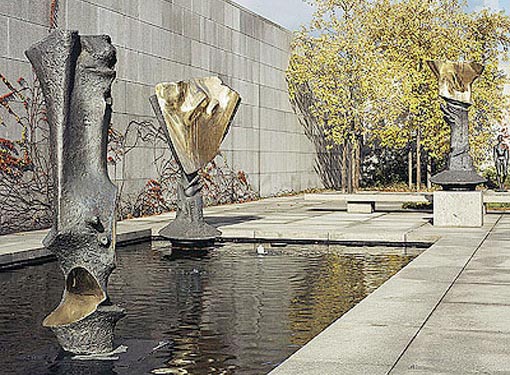Artist:
Bernhard Heiliger
Title:
Drei Vertikale Motive
Year:
1966
Adress:
Potsdamer Strasse 50
www.wikipedia.org:
Bernhard Heiliger (11 November 1915, Stettin - 25 October 1995, Berlin) was a German artist. He was considered "West Germany's foremost sculptor", and his large public artworks are a prominent presence in many German cities, especially Berlin.
Heiliger's diverse output stretches from his early, organically abstracted figures to his late nonobjective, geometric abstractions. His early work (1945–1962), focuses on the human figure, which is treated in an organic style influenced by Aristide Maillol and Henry Moore. Also from this period is a series of portrait busts of prominent contemporary Germans. The artist departed from the human figure in his second period (1962–1970), instead developing imagery of the"flight of birds and vegetable forms" influenced by the nonrepresentational Informelstyle. The seven-meter-high The Flame (Flamme, 1962–63), commissioned by the city of Berlin for Ernst-Reuter-Platz, is considered the key work in the transition between the early and middle periods. The Five Continents (Die fünf Erdteile, 1961), by contrast, still alludes to the human figure in the torso-like shapes that make up the composition.
Kosmos 70, commissioned in 1970 by the city of Berlin for the restored Reichstag building, marks the transition into Heiliger's final period, where spheres and angular forms linked by lines of wire allude to planets and solar systems. The different stylistic phases in Heiliger's career are connected to changes in material: whereas his works from the 50's and 60's are cast materials, such as cast stone or bronze, the works from the 70's onward are most often made of stainless steel or corten steel.
www.art.daimler.com:
Coming from an early working method of abstraction with strongly figurative / vegetable-organic associations, Bernhard Heiliger came to purely abstract sculptures in the early 1980’s, those themes developed purely from the immediate handling of the new artistic material, mainly iron since the 1970’s. Characteristic for this is the task of the closed plastic core, the segmentation of the overall form. Technoid-style individual bodies, circular or triangular surfaces, spheres and rods represent the basic building blocks that, in an open installation, explore the space on all sides like tentacles.
The penetration of body and space is a central concern of 20th century sculpture, which Heiliger tackles in his own way in the playful grouping of stereometric basic bodies. What actually carries the expression is the manifold form analogies, shape correspondences, and contrasts that open up when the constructions are circumvented or passed through. In the counterpoised construction, which remains committed to the ideal of a harmonious overall composition, active-dynamic shapes contrast against resting forms, spatial-graphic elements against spatial-plastic aspects. Heaviness contrasts with lightness, open forms with closed. Force fields seem to build up between the individual parts, suggesting potential movement, detachment, apparent rotation, or tilting. The offer of associations is echoed in the title of the work: force and counterforce, light and shadow, day and night.
Bernhard Heiliger (11 November 1915, Stettin - 25 October 1995, Berlin) was a German artist. He was considered "West Germany's foremost sculptor", and his large public artworks are a prominent presence in many German cities, especially Berlin.
Heiliger's diverse output stretches from his early, organically abstracted figures to his late nonobjective, geometric abstractions. His early work (1945–1962), focuses on the human figure, which is treated in an organic style influenced by Aristide Maillol and Henry Moore. Also from this period is a series of portrait busts of prominent contemporary Germans. The artist departed from the human figure in his second period (1962–1970), instead developing imagery of the"flight of birds and vegetable forms" influenced by the nonrepresentational Informelstyle. The seven-meter-high The Flame (Flamme, 1962–63), commissioned by the city of Berlin for Ernst-Reuter-Platz, is considered the key work in the transition between the early and middle periods. The Five Continents (Die fünf Erdteile, 1961), by contrast, still alludes to the human figure in the torso-like shapes that make up the composition.
Kosmos 70, commissioned in 1970 by the city of Berlin for the restored Reichstag building, marks the transition into Heiliger's final period, where spheres and angular forms linked by lines of wire allude to planets and solar systems. The different stylistic phases in Heiliger's career are connected to changes in material: whereas his works from the 50's and 60's are cast materials, such as cast stone or bronze, the works from the 70's onward are most often made of stainless steel or corten steel.
www.art.daimler.com:
Coming from an early working method of abstraction with strongly figurative / vegetable-organic associations, Bernhard Heiliger came to purely abstract sculptures in the early 1980’s, those themes developed purely from the immediate handling of the new artistic material, mainly iron since the 1970’s. Characteristic for this is the task of the closed plastic core, the segmentation of the overall form. Technoid-style individual bodies, circular or triangular surfaces, spheres and rods represent the basic building blocks that, in an open installation, explore the space on all sides like tentacles.
The penetration of body and space is a central concern of 20th century sculpture, which Heiliger tackles in his own way in the playful grouping of stereometric basic bodies. What actually carries the expression is the manifold form analogies, shape correspondences, and contrasts that open up when the constructions are circumvented or passed through. In the counterpoised construction, which remains committed to the ideal of a harmonious overall composition, active-dynamic shapes contrast against resting forms, spatial-graphic elements against spatial-plastic aspects. Heaviness contrasts with lightness, open forms with closed. Force fields seem to build up between the individual parts, suggesting potential movement, detachment, apparent rotation, or tilting. The offer of associations is echoed in the title of the work: force and counterforce, light and shadow, day and night.



